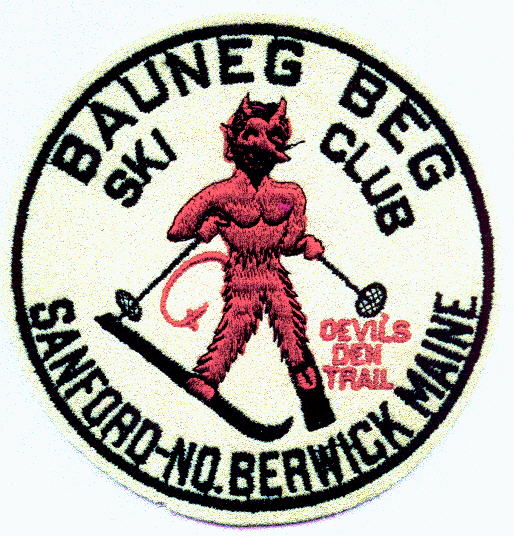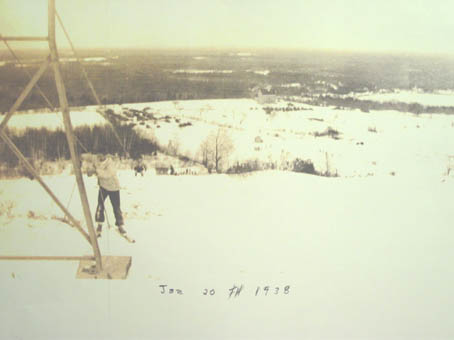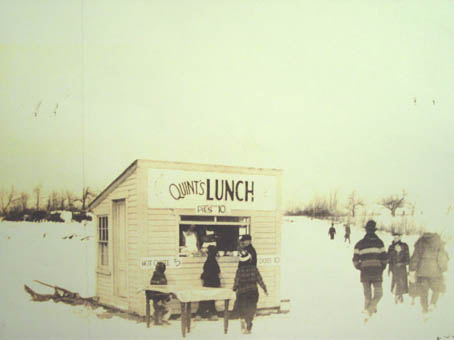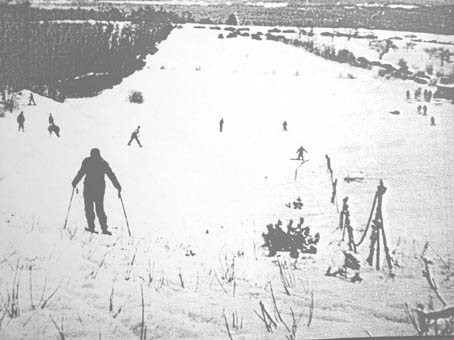Bauneg
Beg
North
Berwick, ME
1938-1958
Bauneg Beg was a classic, early ski club
operated rope tow hill, that was in operation from 1938 to 1958. It featured a
250' drop, an open slope, a Devil's Den Trail, and was on a NE-SE Exposure. The
tow was eventually moved to Bond Mountain in 1958,
resulting in the closing of Bauneg Beg. Today, the area is reforested.
NELSAP is very grateful to
Dave Dutch who wrote the following detailed history of Bauneg Beg, and
for his permission to post the article here. We are also very grateful to
Scott Andrews of
Skiing Past and Present
who also allowed us to post this article.
During the period of the
Great Depression, social and recreational activities flourished
throughout the country as an outlet from hard work and hard times.
Social clubs, fraternal organizations, basketball, bowling and the
theater were popular indoor activities. Baseball and football were
outdoor activities, which one participated or watched.
Downhill skiing increased in popularity as a winter sport in the mid to
late 1930’s and came to York County in 1937. The Bauneg Beg Outing Club
was formed on January 14, 1937 at the D.A. Hurd Library in North
Berwick. Attorney George S. Willard of Sanford was named president.
North Berwick’s Gordon Hilton was vice-president and John Chadbourne was
its treasurer. It was decided to have a rotating secretary. Other
charter members were: Robert Allen, Philip W. Hussey of North Berwick
and Charles Dougherty, Jack Nutter, Raymond Twombley of Sanford.
The club had cleared brush and carved out a trail in the woods on the
property of Bernard Quint, who generously allowed the club to use the
property without compensation, near the intersection of Ford-Quint and
Fox Farm Hill Roads on the leeward side of the 860-foot Bauneg Beg
Mountain.
The 30-degree and 4/5 of mile slope featured a 500-foot rope tow powered
by an 85 horsepower Ford flathead gasoline engine for a cost of $825.
Members hand groomed the 250-foot vertical drop off the rugged
mountainside and skied there all winter, but conditions were less that
ideal.The following season the
club changed their name to the Bauneg Bed Development Corporation. Their
vision was that of grandeur. Philip Hussey, president of the then Hussey
Manufacturing Company in North Berwick, and ski enthusiast, spoke to the
group about his company’s experience and expertise in building ski
jumps. He and chief company engineer, Ed Willey had returned from Lake
Placid, NY touring the Olympic facility there including a ski jump they
had manufactured and installed. They were also thrilled with a bobsled
ride during their visit. |

Patch of Bauneg Beg, courtesy of
Dave Hilton.
Note the Devil's Den Trail logo.
|
|

Thanks to Bob Summa,
Richard Legere, and Deb Dubay, who provided the following three photos
of Bauneg Beg. Here's a view of the rope tow on the top, Jan
20, 1938.
|
Hussey was an innovator in
ski area equipment in the 1930’s. Their Winter Sports Division made
jumps at Gunstock, Berlin, Lebanon, NH, and in Colorado, as well as,
chairlifts and sled runs all over the world.
Jack Nutter was elected president in 1938 and there were 225 paid
members. A 4000-watt generator was purchased and installed to produce
electricity for a snack bar, warming hut and floodlights.
The grand opening for the members and public was held on Sunday,
January 9, 1938. The weather cooperated somewhat providing 4-5 inches of
new snow. Not ideal, but a reported 1000 people came to the hill to ski,
toboggan and snowshoe. Traffic was snarled on both Ford-Quint and Fox
Farm Hill Roads. The following weekend Bernard Quint plowed out a field
after a heavy snowfall to hold 315 cars.
Fifteen hundred patrons attended and enjoyed a day of ideal conditions.
Members were invited to a moonlight ski in the evening followed by an
oyster stew at a nearby farmhouse.
Subsequent weekends were just as successful and free busses ran from
Sanford, Biddeford and Portland to the slope. Snow was plowed and piled
up to make a temporary ski jump. A jumping club from Biddeford put on
exhibitions. The trail that had been previously cut through the rugged
terrain had to be modified for safety. The trail dubbed Devils Den,
named after Bauneg Beg folklore, was over 2000-feet long and
intermediate skiers at best would dodge boulders and trees during their
speedy run.
Harland Roberts who grew up abutting the slope recalls the early days
of its operation. “It was surprising how many people went there on
weekends. Cars were parked on both sides of the roads. Asked if he knew
what the lift ticket price was then, he countered, “I don’t know, I
never paid I just went over there.” Some skiers wandered off course and
shushed down his family’s field and jumped the road and went down
another field. A fete he tried a number of times. |
In February of 1939, the club planned
its first annual winter carnival. North Berwick High School
teacher-coach Leslie Marston was named completion director. A downhill
and slalom combined race was to be held. A queen was crowned and the
closing ceremony and dinner at the Bauneg Beg Grange Hall, rounded out
the day’s festivities.
Al Peel bested runner-up Henry Kidder in the combined and was presented
the 13-inch Hussey Cup by donor Phil Hussey. Miriam Diggery of Sanford
was elected queen. A reported crowd of 3000 attended the two-day event.
Afternoon and evening lift tickets were 25 cents for kids, 50 cents for
adults and 50 cents for the dinner. Ideal conditions blessed the event
as the area was hit with the worst blizzard since 1888.
The following weekend, the club was invited by the Tenerife Ski Club of
Milton Mills, NH and took top honors in competition there. Sanford’s
Wendell Thayer earned the title of ski meister. Local skiers traveled to
other
slopes in the region and most came home with hardware.
Prior to the 1939-40 season, local merchants displayed ski apparel, ski
boots, wooden skis and bamboo poles to purchase at the grange hall. This
equipment was a far cry from the modern and safer gear of today. The
club made final payment to Hussey for the fabrication of the tow and
granted Nasson College use of the hill and tow. A warming hut was added
and the Quint family ran a snack bar featuring hot coffee, hot chocolate
and food at the base of the slope.
The second annual carnival was even a greater success than the first. An
estimated crowd of 4000 attended. The Goodall Worsted Company made
competitor bibs and slalom flags. Thayer-Diggery would present a loving
cup to the queen. |

Quint's Lunch served up snacks, hot
chocolate, and pies.
|
Numerous teams from other ski areas competed, but the local club bested the
Garrison Outing Club of Dover. Wendell Thayer dethroned Al Peel and had a
downhill-slalom combined time of 80.5 seconds. York High School won the high
school division and Mrs. Dorrance (Frances) Goodwin was queen.
In 1941, Avon D. Hilton of Portland and former ski instructor at Bridgton’s
Pleasant Mountain held ski classes on weekends at the slope. The third annual
carnival in 1941 was postponed from February to March because of lack of snow
and when it was held, only the combined races were held and Sanford’s Mike
Shaffer and Bud Bullard had identical times. A other events, including the
crowning of the queen and closing event were cancelled.
In the 40’s, the interest in the slope diminished due to wartime travel
restrictions and its use in daytime, and the rationing of gasoline. Car-pooling
became necessary. The early 40’s saw light snowfalls and poor skiing. The
carnivals were canceled through 1946. In March of 1941, club president Arnold
Stansfield started a group of skiers with Red Cross first aid training for them
to become certified ski patrol members because there were numerous skiing
accidents on the hill.
|

View from the summit.
|
News accounts were sparse
in these war years, but in 1945, Roger Woodward was reelected president
and the ski area was renamed Bauneg Beg Ski Region. The YMCA paid for
its members to have blanket use of the facility and service men and
women were to ski free. It was hoped that the upcoming season would get
the club out of the “red.” Liability insurance was purchased and a fund
was started to build a fireplace for the warming hut.
As luck would have it, excellent snow conditions would grace the slope
and several competitions, the first since the outbreak of the war, were
scheduled. Al Peel who won the Downhill in 1939, and who was just
discharged from the Army, won the event with Jack Nutter second. The
following week Slalom was held with Lawrence Sherburne winning with
Nutter bridesmaid again.
The first informal interscholastic ski meet between Sanford and
Spaulding of Rochester was held near the end of the 1945 season.
Late December 1945 and early January saw good conditions at the slope.
The club was out of the “red,” the war was over and great expectations
became alive. Plans were made to revive the successful Winter Carnival.
Phil Hussey’s workers fixed the problem of the ski tow rope coming off
their pulleys.
A “January Thaw” dampened spirits, but heavy snowfalls later in the
month and in February ripened conditions for the Carnival. The Carnival
ball was held at the Thomas W. Cole Post Legion hall and Margary
Shoesmith was elected queen. Jack Nutter won the combined slalom and
downhill, the feature event, besting Roger Woodward and Al Peel. Nutter
was presented the Hussey Cup. Peel, the favorite, was penalized for
missing a gate in the slalom. |
Sanford’s Company C of the Maine State guard assisted in the skiing events,
directing traffic and used radio communications for the first time. The club’s
active ski patrol was also assisting.
During this time, both Sanford High and Nasson College held their carnivals and
used the facilities at the hill. Spring skiing was enjoyed and Jack Nutter, Joe
Downs, Wendell Thayer and Bob Wilson trekked to Lac Beauport, Quebec for skiing
competition.
In 1946, the Springvale Bottling Company used the Bauneg Beg label and depiction
of a downhill skier as its logo. They were a large local bottler and distributor
of soda.
Plans for the 1947 season were optimistically planned and the winter carnival
was scheduled earlier in February. An estimated 2000 spectators watched
thrilling races including the popular downhill and slalom combined that was won
by Mike Shaffer followed by Lawrence Sherburne and Roger Woodcock. Carleton
Sevigny and Margary Shoesmith of Sanford High won the new Lester H. Willard
Award for the top high school finishers, presented and given by Jack Nutter.
Jane Rupp was elected queen and skied collegiately at Middlebury.
The following year snow conditions at the hill were posted at the Dugout in
Sanford and post office in North Berwick. Jack’s Diner in Sanford took over
concessions from the Quint Family during the 1948 season. What was becoming the
highlight of the winter social calendar; plans for the sixth annual carnival
were drawn up.
The ski club sponsored a series of Devil’s Den downhill races held in January
and they were won in order by John Garnsey and twice by Bob Wilson. Wilson had a
record run of 37.7 seconds in his first win.
In 1949, anyone was eligible to vote for the queen and sixteen-year old Claire
Thiboutot for SHS won the crown from girls from Sanford, St. Ignatius, North
Berwick and Wells High Schools and Nasson College. A large crowd attended the
ball held at the Sanford Town Hall.
A record five teams and 48 participants entered the event. Carl Lilljedahl of
Milton, NH, won the D&S Open Combined, while Sanford High senior John Jellerson
won the Hussey Cup. Jellerson and Jane Rupp won the Willard Award. |

A bottle from the Springvale Bottling
Company, using the logo of the skier from Bauneg Beg. Courtesy
Jim Johansen.
|
Alfred’s Frank Scott fondly recalls his days at Bauneg Beg. “I first started
skiing in junior high school and would walk and carry my skis and poles over my
shoulder on Saturday mornings. Occasionally Jack and Tom Nutter and others would
pick me up. We spent the morning sidestepping up and down the hill to pack the
powder or break up the ice and I lugged 5-gallon cans of gasoline up the hill
for the engine.” When asked about the Devil’s Den, he smiled and said, “It was
fun, I flew down there. I was young and fearless.”
Scott first competed there in the grammar school division and won the slalom and
a 50-yard dash on skis in 1948. Frank was the only representative of the 1952
Sanford High School ski team that competed in the state championships in
Rumford. “I was wild on skis and crashed out in both the downhill and slalom,”
Scott said. Scott first started on wooden slats and bought his first pair of
aluminum skis from the Dugout sports store in Sanford in 1949.
During the winter of 1950 the slope was desperate for snow. Skiers burned old
wooden skis and poles in a ceremony to appease Gerda the Norse snow goddess. It
apparently worked, but less than ideal condition all but ended competitive
skiing there.
The Nutter girls, Pat and Sally remembered their introduction to skiing at
Bauneg Beg along with their parents Jack and Dot and brother Tom. Sally, now
Mrs. Cliff Carpenter of Apple Valley, MN and Pat Leighton of Falmouth started
young and it became a family affair. “Mom made sandwiches to sell at the warming
hut for 10 cents,” Pat recants. Pat also remembered helping cut the hay, brush
and remove rocks from the slope and Devil’s Den Trail in the fall. Sally was
little and stayed with her mom in the hut. Both were glad that this writer was
‘bringing Bauneg Beg alive.”
Pat continued a long career in skiing and skied at UNH. She was one of the top
20 women’s skiers in the East and competed with Olympians Andrea Mead Lawrence
and Penny Pitou of NH. She coached skiing in Middlebury, VT and Denver, CO and
was a longtime instructor at Pleasant MT/Shawnee Peak in Bridgton.
In the late 1940’s and early 50’s, the local area Boy Scouts held winter
jamboree’s there and held competition in the downhill and slalom races. North
Berwick’s Troop 312 swept the events with 312’s Roger Charles Littlefield,
skimeister. Nasson College, high schools and other groups held outings there as
well.
Because of the sport’s increasing popularity, space limitations and the
unreliability of quality snow cover, the tow was moved further north to
Bond Mountain off Route 11 in Newfield in the fall of
1958. It too succumbed to the lure of the grandiose and all-inclusive resorts of
northern Maine and New Hampshire.
In the 1990’s the Legere family opened a 110’ vertical drop and 340’ feet long
slope with a pony rope tow bought from Rotary Park in Biddeford. It had a
warming hut and skating pond. This was located down the road on Ford Quint from
the original ski area. This too, succumbed to weather and economics.
Today there is little evidence of the old Bauneg Beg ski area. Instead, the once
grassy slope hayed by Bernard Quint in the summers, is a heavily forested
hillside with only the memories of its past embedded in the minds of those who
skied there.
Last updated: Dec 24, 2013
Head
back to Lost Maine Ski Areas
Head
back to the main page




